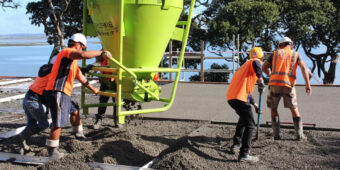Rethinking building design to outlive earthquakes
21 Nov 2025, Industry News, News

New University of Canterbury research has demonstrated how small design changes that make buildings stiffer can reduce earthquake damage and save billions of dollars
The international study led by Te Whare Wānanga o Waitaha | University of Canterbury (UC) researcher Professor Santiago Pujol has found that limiting how much buildings sway during earthquakes could dramatically reduce damage across New Zealand.
Working in collaboration with the National Center for Research on Earthquake Engineering (NCREE) in Taiwan and the Te Hiranga Rū QuakeCoRE research centre, Professor Pujol and his team carried out a large-scale structural test, combining steel framing and reinforced-concrete walls to replicate the kind of buildings being constructed in New Zealand.
Professor Pujol said the main goal of the research was to mirror conditions playing out ‘on the ground’.
“The main goal was to conduct a large-scale test representing, as well as possible, a building that reflects what’s actually being built out there, not an idealised model,” he said.
Drift is key to earthquake performance
The research showed if engineers can keep storey drift, which is the sideways movement between floors, below about 1% of the storey height, most damage to current building components becomes cosmetic rather than structural.
“As long as the storey-drift ratio was less than 1%, the damage was quite tolerable, even in materials as brittle as gypsum board,” Pujol explained.
“When drift exceeds that, you start seeing cracked walls, jammed doors and broken windows, even though the building might still stand.”
“It only costs up to 2% extra [from the total building cost] to make a building that is much better, one you can live in after a quake, not one you have to abandon,” Pujol said.
“That small investment at the design stage could save billions of dollars in rebuilding and insurance costs after major seismic events.
“When you buy a car, if someone offered you 1% off but it didn’t have airbags or seatbelts, would you buy it?”
The study reinforces that controlling drift, not just strength, is key to keeping buildings usable after major earthquakes.
Potential policy implications
The implications reach beyond engineering. Insurance companies and policymakers are already looking for clear definitions of ‘damage’ to inform future regulations and coverage. The research will also provide data as New Zealand moves to tighten drift limits, which are expected to come into force by 2027.
“Right now, we’re looking at introducing tighter drift limits in New Zealand,” he says. “Japan and Chile have had strict limits for decades, and they’ve proven effective.
“You can retrofit [buildings], but it’s expensive and difficult. We’re researching ways to add stiffness externally, for example, by tying new concrete walls to the outside of existing buildings. However, it’s better to build more robust buildings to begin with, especially if we admit that our estimates of the seismic hazard are just that: estimates.”
Legislative updates to earthquake-prone buildings
While the research above looks to increase building longevity following an earthquake, the Building Act only requires that buildings are resilient enough to ensure people in them will survive an earthquake.
To this end, the Government has announced proposed legislative changes aimed at making the earthquake-prone building (EPB) regime more risk-based and proportionate by focusing on higher seismic risk areas and high-risk buildings.
Under Construction has previously reported how the Government plans to reset New Zealand’s EPB regime.
Building and Construction Minister Chris Penk said on September 29: “The Government is removing the New Building Standard (NBS) percentage ratings currently used by engineers to determine whether a property is earthquake-prone,” said Penk.
“The NBS rates how an existing building is expected to perform in an earthquake compared to a new building and has proven [to be] too broad and inconsistent.”
Under the revised rules, all buildings in low-seismic risk zones – such as Auckland, Northland and the Chatham Islands – will be removed from the EPB framework entirely. The focus will instead fall on high- and medium-risk areas, where certain structural types, such as unreinforced masonry or older concrete buildings over three storeys, will remain subject to regulation.
Register to earn LBP Points Sign in



